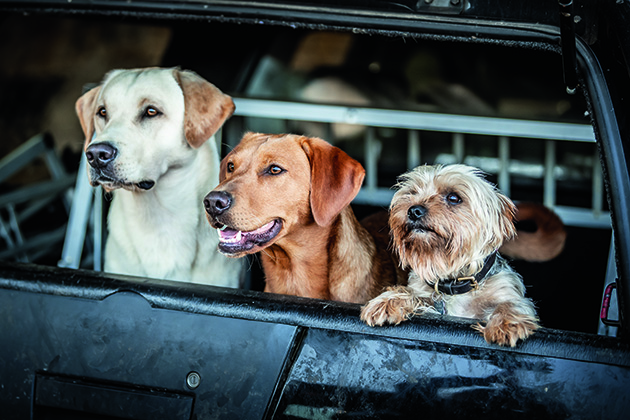Transporting dogs in cars: are you breaking the law?
It's reckless to leave dogs unrestrained in cars and it could also affect an insurance claim, warns vet Tony Buckwell

Safety, security and comfort are essential when transporting dogs

A loose dog in the car could break the terms of your insurance and land you with a big bill to pay
Transporting dogs in cars – be safe and secure
The Highway Code includes advice on transporting dogs in cars and requires animals be “suitably restrained so they cannot distract you while you are driving”. The Welfare of Animals (Transport) Order requires that “no person shall transport an animal in a way which causes or is likely to cause injury or unnecessary suffering to that animal”. (Read bringing home a puppy for the first time.)

This is fine when you’re parked but not the way to travel with dogs driving along the road.
Dogs sticking heads out of windows
Dogs might seem to enjoy it but insurers Direct Line would like a ban on dogs sticking their heads out of car windows. The company’s research revealed that 47% of dog-owning drivers allow their pets to do this, with some 28% suffering an injury as a result. Presumably dogs like the rush of smells and the wind in their ears.
Crates and harnesses for dogs in cars
The safest place for a dog to travel is undoubtedly in a crate in the rear of the vehicle, while the worst place an unrestrained dog can travel is on the back seat of a car, as the risk of it being catapulted forward under emergency braking is considerable. In theory, the police already have the power to give a driver a fixed penalty notice if an unrestrained dog is deemed to be a distraction that could lead to careless driving, and a dog with its head out of the window is certainly distracting.
When driving with your dog in the vehicle on a public highway, the Highway Code recommends that, “a seat belt harness, pet carrier, dog cage, or dog guard are ways of restraining animals in cars”. A loose pet in the car could break the terms of your insurance and leave you with a big bill to pay if you’re in an accident. It may also invalidate your gundog insurance if they are injured and need treatment.
If a dog is restless and won’t settle during the journey, try using dog-appeasing pheromone, which can be provided either in the form of an impregnated collar or sprayed on the dog’s bedding. (Read our list of the best products for calming anxious dogs.)

A robust and secure transit box is the most appropriate option for working gundogs
The most appropriate option for working gundogs is to restrain them in a suitably robust and secure dog crate or transit box that you slot into the back of the vehicle. Not only are crates the most secure way for transporting dogs in cars, lockable boxes help to deter thieves and keep the car’s upholstery intact.
However, dogs can be daunted by a crate to start with, so try introducing them to it before using it in the car. Leave it around the house with treats or toys inside to help your dog build positive associations. The dog should be able to see out of the crate, which should be large enough to allow the dog to stand comfortably, turn around easily and lie down in a natural position.
Lintran has been manufacturing transit boxes for gundogs since 1988 and its pickup ranges have won several awards. Its owner Isobel Hopkins explains: “It’s like a mobile kennel or bed for them to make them feel safe and happy.
“However, crates shouldn’t be too big because, in the case of an accident, one that is too large will give more room for your dog to be thrown around and increases risk of injury.
“Boxes should be well ventilated and not closed in as vehicles can get very warm — in winter as well as summer — especially if the dogs have been working. Most boxes offer a mesh top and rear view or ventilation panel to help keep the dogs cool.”

Keeping an eye on things
Other alternatives for transporting dogs in cars
“Alternatives can include dog guards and tailgates,” says Isobel, “and these offer some protection to keep dogs in the rear area. But in the event of an accident, the dogs could become loose and able to exit via doors or windows if the vehicle is seriously damaged.”
Unlike human safety devices, there is no legal requirement for these products to be crash tested, so it can be difficult to know how much protection they would actually provide your dog in the event of an accident. You might also check that pets are allowed to travel with the breakdown service you use in case of emergencies. (Read more on how to keep dogs safe from car collisions.)
Long journeys
If you’re travelling over long distances, don’t feed your dog for two hours prior to a journey so it does not have to travel on a full stomach. On a long journey that includes a period when the dog would normally be fed, interrupt the journey at the appropriate time, provide a light meal and allow the dog time to start digesting its food before continuing your journey. (Read our advice on car sickness in dogs).
This is also a good opportunity to allow your dog time to stretch its legs and go to the toilet. Regular breaks are always advisable, so make sure you allow extra time. Finally, if your dog is unfortunate and has developed a secondary fear of travelling in the car, your vet will be able to prescribe travel sickness tablets.








